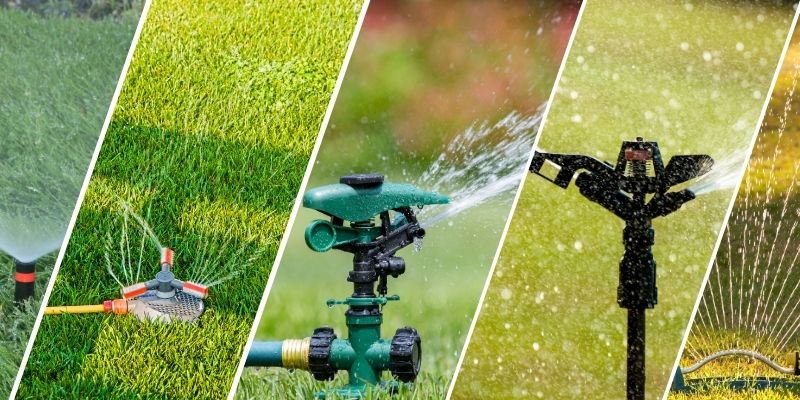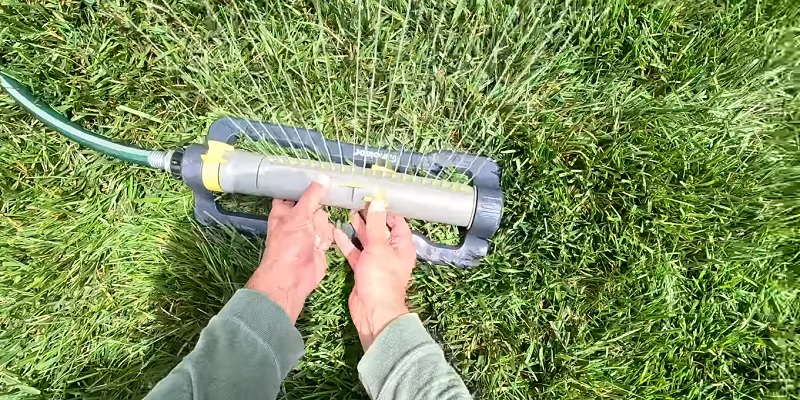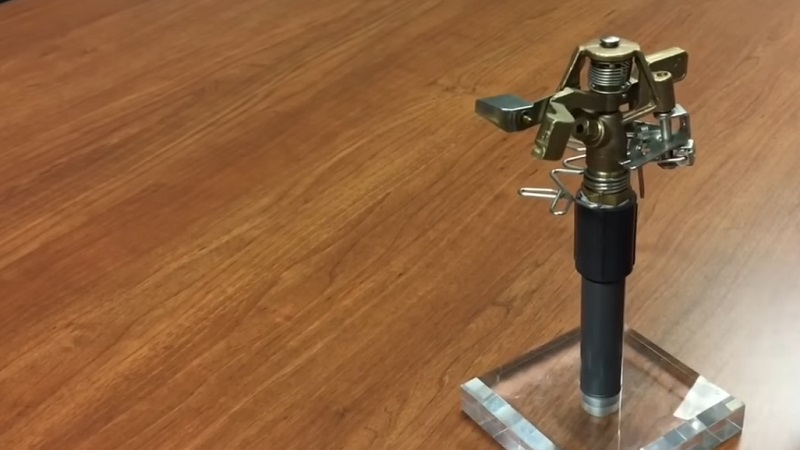Have you ever looked at your neighbor’s lush, green lawn and wondered, “What’s their secret?” Well, one of the biggest factors in maintaining a healthy lawn is proper watering. And that’s where lawn sprinklers come in!
Choosing the right sprinkler for your lawn isn’t just about keeping the grass green. It’s about using water efficiently, saving time, and making sure every part of your yard gets the care it needs. But with so many types of sprinklers out there, how do you know which one is best for your lawn?

Don’t worry! We’re here to help. In this guide, we’ll walk you through the different types of sprinklers available, from simple stationary sprinklers to high-tech in-ground systems. We’ll look at what works best for small lawns, large yards, vegetable gardens, and everything in between.
We’ll break down the pros and cons of each type, so you can make the best choice for your specific needs. Whether you’re a first-time homeowner or a seasoned gardener looking to upgrade your watering system, this guide has got you covered.
So, let’s dive in and explore the world of lawn sprinklers. By the end of this article, you’ll be equipped with all the knowledge you need to keep your lawn looking its best, no matter its size or shape. Ready to turn your lawn into the envy of the neighborhood? Let’s get started!
Types of Sprinklers
Stationary Sprinklers
Stationary sprinklers are the simplest type of lawn sprinklers. As the name suggests, these sprinklers stay in one place and spray water in a fixed pattern. They come in various shapes, like circles or squares, and can cover small to medium-sized areas.
Pros:
- Affordable and widely available
- Easy to use and set up
- Great for small, oddly shaped areas
- Low maintenance
Cons:
- Limited coverage area
- May need frequent repositioning for larger lawns
- Can create uneven watering if not properly placed
Best uses: Stationary sprinklers are ideal for small lawns, flower beds, or specific areas of your yard that need extra attention. They’re perfect for beginners or those on a tight budget.
Oscillating Sprinklers

Oscillating sprinklers have a long tube with multiple openings. The tube moves back and forth, creating a fan-shaped spray of water. This motion helps cover a larger, rectangular area.
Pros:
- Covers medium to large rectangular areas efficiently
- Even water distribution
- Adjustable spray width and distance
- Affordable and easy to use
Cons:
- Not ideal for irregularly shaped lawns
- Can waste water in windy conditions
- May require repositioning for complete coverage of large areas
Best uses: Oscillating sprinklers work best for medium-sized lawns, especially those with a rectangular shape. They’re great for watering long stretches of grass, like the area between a sidewalk and the street.
When choosing between these two types, consider the size and shape of your lawn. For small or oddly shaped areas, a stationary sprinkler might be your best bet. If you have a larger, rectangular lawn, an oscillating sprinkler could be more efficient.
Remember, the key to effective watering isn’t just choosing the right sprinkler – it’s also about using it correctly. Make sure to position your sprinkler for even coverage and water during the cooler parts of the day to minimize evaporation.
We’ll explore more advanced sprinkler types that are suitable for larger lawns and specialized uses.
Impact Sprinklers

Impact sprinklers, also known as impulse sprinklers, are those classic sprinklers that make a distinctive clicking sound as they rotate. They use the force of water to power a rotating arm that sprays water in a circular pattern.
Pros:
- Covers large areas efficiently
- Adjustable spray distance and arc
- Works well with high water pressure
- Durable and long-lasting
- Can handle debris in water better than other types
Cons:
- Can be noisy due to the clicking mechanism
- May be too powerful for delicate plants or newly seeded areas
- More complex to adjust than simpler sprinkler types
Best uses: Impact sprinklers are excellent for large lawns, commercial properties, and agricultural use. They’re particularly effective in areas with high water pressure and where durability is a key factor.
Rotating Sprinklers
Rotating sprinklers, also called rotary sprinklers, have multiple arms that spin as water flows through them. They typically create a gentle, rain-like spray pattern that covers a circular area.
Pros:
- Gentle watering action, good for delicate plants and new grass
- Even water distribution
- Can cover medium to large areas
- Often more water-efficient than other types
- Typically quiet operation
Cons:
- May not work as well with low water pressure
- Some models can be prone to clogging
- Limited adjustability in some basic models
Best uses: Rotating sprinklers are versatile and work well for medium to large lawns. They’re particularly good for areas with established grass or gardens with a mix of plants that benefit from gentle watering.
When deciding between impact and rotating sprinklers, consider factors like your lawn size, water pressure, and noise tolerance. Impact sprinklers are great for large, open spaces where noise isn’t an issue, while rotating sprinklers offer a gentler touch that’s suitable for a wider range of plants and grass types.
Both these sprinkler types offer more coverage than stationary or oscillating sprinklers, making them good choices for larger lawns. However, they may require more setup and adjustment to ensure proper coverage.
We’ll cover some more specialized sprinkler types, including traveling sprinklers and drip irrigation systems.
Traveling Sprinklers
Traveling sprinklers, often called “lawn tractors,” are self-propelled devices that move along a predetermined path while watering your lawn. They typically have wheels and look like small tractors.
Pros:
- Can cover large areas without needing to be moved manually
- Provides even watering along its path
- Fun and unique design
- Good for irregularly shaped lawns
- Can save time and effort for large properties
Cons:
- More expensive than basic sprinkler types
- Requires setup of the “track” (usually a hose) before use
- May get stuck on obstacles or uneven terrain
- Can be overkill for small lawns
Best uses: Traveling sprinklers are ideal for large lawns, especially those with irregular shapes that are difficult to water with stationary sprinklers. They’re great for homeowners who want to automate their lawn watering process.
Drip Irrigation Systems
Drip irrigation systems deliver water directly to plant roots through a network of tubes with small holes or emitters. While not technically a “sprinkler,” they’re an important watering option to consider.
Pros:
- Extremely water-efficient, minimizing waste and evaporation
- Delivers water precisely where needed
- Reduces weed growth and plant diseases
- Can be automated and customized for different plant needs
- Works well in vegetable gardens and flower beds
Cons:
- Initial setup can be complex and time-consuming
- More expensive upfront than traditional sprinklers
- May require maintenance to prevent clogging
- Not ideal for general lawn watering
Best uses: Drip irrigation systems are perfect for vegetable gardens, flower beds, and areas with specific watering needs. They’re also great for conserving water in drought-prone areas or for environmentally conscious gardeners.
When choosing between these systems, consider your specific needs. Traveling sprinklers are best for those with large lawns who want to automate the watering process without installing a permanent system. Drip irrigation, on the other hand, is ideal for targeted watering of specific plants or garden areas.
Both these options offer more specialized solutions compared to traditional sprinklers. Traveling sprinklers provide a unique way to water large areas, while drip irrigation offers unparalleled efficiency for specific plantings.
Next, we’ll cover in-ground sprinkler systems, which offer a permanent solution for lawn watering.
In-Ground Sprinkler Systems
In-ground sprinkler systems are permanent installations that consist of a network of pipes and sprinkler heads installed below the surface of your lawn. These systems can be programmed to water your lawn automatically according to a set schedule.
Pros:
- Fully automated watering with customizable schedules
- Even coverage across the entire lawn
- Can be zoned for different watering needs in various areas
- Improves property value
- Saves time and effort in the long run
- Can be more water-efficient when properly programmed
Cons:
- High initial cost for installation
- Requires professional installation in most cases
- Potential for underground leaks or damaged pipes
- May need winterization in colder climates
- Repairs can be complex and may require professional help
Best uses: In-ground sprinkler systems are ideal for homeowners who want a long-term, low-maintenance solution for watering their lawns. They’re great for all lawn sizes but are particularly beneficial for large properties or those with complex landscaping needs.
Choosing the Right Sprinkler for Different Lawn Types
Now that we’ve covered all the major types of sprinklers, let’s discuss how to choose the right one for different lawn situations:
Small Lawns
Best options: Stationary sprinklers, oscillating sprinklers
Considerations: Easy to set up and move, affordable, sufficient for small areas
Large Lawns
Best options: Impact sprinklers, rotating sprinklers, traveling sprinklers, in-ground systems
Considerations: Coverage area, water pressure, ease of moving or automation
Vegetable Gardens
Best options: Drip irrigation systems, stationary sprinklers with gentle spray
Considerations: Precise water delivery, avoiding wet foliage to prevent disease
General Yard Maintenance
Best options: Depends on yard size and shape, often a combination of types
Considerations: Versatility, ease of use, coverage of different areas
When choosing a sprinkler system, it’s important to consider not just the size of your lawn, but also its shape, your local climate, water pressure, and your personal preferences in terms of maintenance and automation.
Factors to Consider When Choosing a Sprinkler
When selecting the ideal sprinkler system for your lawn, several crucial factors come into play. Understanding these elements will help you make an informed decision that best suits your specific needs.
Lawn Size and Shape
The dimensions and configuration of your lawn play a pivotal role in choosing the right sprinkler. Start by accurately measuring your lawn area to ensure adequate coverage. Remember that irregularly shaped lawns may require more strategic placement or multiple sprinkler types to achieve uniform watering. For instance, a long, narrow strip of lawn might benefit from an oscillating sprinkler, while a large, open area could be better served by an impact or rotating sprinkler.
Water Pressure
Your home’s water pressure is a critical factor that often gets overlooked. Different sprinkler types have varying water pressure requirements to function optimally. Before purchasing a sprinkler, check your home’s water pressure. High-pressure systems can accommodate most sprinkler types, but if you have low water pressure, your options may be limited. In such cases, you might need to consider low-pressure sprinklers or invest in a pump to boost your water pressure.
Soil Type
The composition of your soil significantly influences how water is absorbed and retained. Sandy soils, known for quick drainage, typically require more frequent watering sessions of shorter duration. This prevents water from draining away before plants can absorb it. On the other hand, clay soils retain water for longer periods, benefiting from less frequent but slower watering to allow proper absorption and prevent runoff. Understanding your soil type helps in programming your sprinkler system for optimal efficiency.
Climate and Rainfall
Your local climate and typical rainfall patterns should heavily influence your sprinkler choice. In regions with regular rainfall, you might opt for a simpler system that supplements natural precipitation. Conversely, arid climates demand more efficient and potentially more sophisticated watering systems. Consider sprinklers with smart technology that can adjust to weather conditions, or drought-resistant options like drip irrigation systems for water conservation in dry areas.
Budget Considerations
When evaluating sprinkler systems, it’s crucial to look beyond the initial purchase price. Factor in long-term water usage, potential water savings, and maintenance costs. While more efficient systems like in-ground sprinklers or drip irrigation may have higher upfront costs, they can lead to significant water and cost savings over time. Additionally, some regions offer rebates or incentives for installing water-efficient irrigation systems, which could offset initial expenses.
Best Overall Sprinkler Types for Various Situations
Versatility Champion
Rotating sprinklers stand out for their adaptability to various lawn sizes and shapes. Their adjustable spray patterns and distance controls make them suitable for both small gardens and larger lawns. Many models allow for fine-tuning of water distribution, ensuring even coverage across different areas of your yard.
Water Conservation Heroes
For the eco-conscious gardener, drip irrigation systems reign supreme in water efficiency. These systems deliver water directly to plant roots, minimizing evaporation and runoff. They’re ideal for vegetable gardens, flower beds, and areas with precise watering needs. For larger lawns, smart in-ground systems equipped with soil moisture sensors and weather monitors can significantly reduce water waste by adjusting watering schedules based on real-time conditions.
Large Area Conquerors
When dealing with expansive lawns, impact sprinklers and traveling sprinklers shine. Impact sprinklers can cover vast areas with their powerful, rotating streams. Traveling sprinklers offer the added benefit of mobility, methodically moving across your lawn to ensure comprehensive coverage with minimal effort on your part.
Small Space Solutions
For compact yards or specific garden areas, stationary sprinklers provide a simple yet effective solution. Their targeted watering is perfect for small lawns, flower beds, or newly seeded areas that require gentle, precise watering. Some models offer adjustable spray patterns, adding a degree of versatility to these straightforward devices.
Maintenance: Keeping Your Sprinklers in Top Shape
Proper maintenance is key to ensuring the longevity and efficiency of your sprinkler system. Regularly inspect your sprinklers for clogged nozzles or heads, as these can lead to uneven water distribution and wasted water.
Adjust your sprinkler heads seasonally to account for changes in plant growth and sun exposure. In colder climates, winterizing your system is crucial to prevent freeze damage to pipes and components. Promptly replacing worn-out parts not only maintains efficiency but can also prevent more costly repairs down the line.
By carefully considering these factors and understanding the strengths of different sprinkler types, you can select a watering solution that will keep your lawn lush and healthy while optimizing water usage and minimizing maintenance efforts.
FAQs About Lawn Sprinklers
How often should I water my lawn?
The frequency of watering depends on your climate, soil type, grass species, and season. Generally, lawns need about 1-1.5 inches of water per week, either from rainfall or irrigation. It’s better to water deeply and less frequently to encourage deep root growth.
Read Here: How Long to Water Garden with Sprinkler
What’s the best time of day to water my lawn?
Early morning, typically between 4 AM and 10 AM, is the best time to water. This allows water to soak into the soil before evaporation becomes significant, and gives grass blades time to dry, reducing the risk of fungal diseases.
Read Here: When is the Best Time to Water Grass in Hot Weather?
Can I install an in-ground sprinkler system myself?
While it’s possible for a skilled DIYer to install an in-ground system, it’s generally recommended to hire professionals. They can ensure proper design, adherence to local codes, and optimal placement for efficient watering.
How do I know if my lawn is getting enough water?
Check your soil moisture by inserting a screwdriver into the ground. If it goes in easily, your soil is moist enough. If it’s difficult to insert, your lawn may need watering. Also, look for signs of water stress like wilting or discoloration.
Are smart sprinkler systems worth the investment?
Smart systems can significantly reduce water waste and save money in the long run, especially in areas with high water costs or frequent droughts. They’re particularly valuable for busy homeowners or those with large lawns.
How do I prevent my sprinkler from watering the sidewalk or driveway?
Adjust the spray pattern and angle of your sprinkler heads to focus on your lawn. For in-ground systems, consider using heads with adjustable arcs or installing them closer to paved areas.
What should I do with my sprinkler system in winter?
In areas where temperatures drop below freezing, it’s crucial to winterize your system. This typically involves shutting off the water supply and blowing out any remaining water from the pipes to prevent freezing and damage.
How can I tell if my sprinkler system has a leak?
Signs of a leak include unusually high water bills, wet spots in your yard, or areas of grass that are much greener than others. For in-ground systems, a sudden drop in water pressure can also indicate a leak.
Is it better to water my lawn for a short time every day or for a longer time less frequently?
It’s generally better to water less frequently but for longer periods. This encourages deeper root growth, making your lawn more drought-resistant. Short, daily watering can lead to shallow root systems.
Can I use my sprinkler system for my vegetable garden?
While possible, it’s not ideal. Vegetable gardens often have different watering needs than lawns. Drip irrigation or soaker hoses are usually more effective for gardens, as they deliver water directly to the plant roots and reduce the risk of fungal diseases.
Final Thoughts
Selecting the right sprinkler system is crucial for maintaining a healthy lawn while conserving water and minimizing effort. Consider your lawn’s size, shape, local climate, soil type, and your budget when making your choice. Remember, the best system balances efficiency, coverage, and ease of use. Whether you opt for a simple stationary sprinkler for a small yard or an advanced in-ground system for a large property, the goal is the same: a lush, green lawn that enhances your home and lifestyle. By choosing wisely and watering efficiently, you’ll enjoy the benefits of a well-maintained landscape for years to come.


